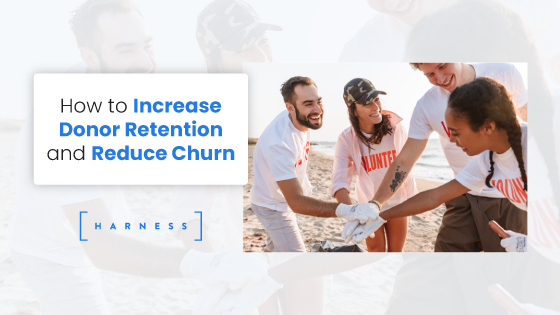How to Increase Donor Retention and Reduce Churn
In this post, we cover how to calculate (as a percentage) your donor retention and churn over a specific period of time. These metrics will tell you what percentage of your donors you retained and lost (churned) over a given period.
Ideally, you want your retention as high as possible and your churn as low as possible, meaning that you keep more donors than you lose. Generally, it costs more to acquire new donors than it does to maintain existing ones (especially if these donors make recurring donations), so tracking, and making decisions to reduce, churn is key.
Calculating Retention and Churn
We will explore retention and churn by calculating these percentages for the Lutz Animal Shelter for the month of January.
At the start of January they had 100 recurring donors. Throughout the month, they gained 30 new recurring donors and lost 10. This left them with 120 recurring donors at the end of the month/the start of February.
So, how do we calculate retention and churn?
Calculating Retention
Retention, simply put, is the percentage of donors who will donate again. They are your existing donors who stick around and stay subscribed for the following month. The higher the retention rate, the more recurring donors.
We know that the Lutz Animal Shelter had 100 recurring donors at the start of January, and we are interested in what percentage of previously existing donors stuck with Lutz going into February. So, the period we are looking at is one month, January.
To calculate Lutz's retention, we first want to set up a ratio of the number of donors who remained and the number of donors at the start of the measured period.
That looks like this:

We know that Lutz had 100 donors at the start of January and that they lost 10 over the course of the month. So, at they end of the month they had 90 ongoing donors remaining. The reason we are not worrying about the customers they gained right now is because we are looking to calculate the percentage of those who were retained. In other words, subscribers who were already subscribed at the top of the month.
So, that equation, with the variables plugged in, and the initial donors who remained (100 - 10 = 90) calculated looks like this:

You will notice that the ratio is multiplied by 100. This is convert the fraction/decimal that the ratio gives us into a percentage.
So, we calculate the equation and we get:

Lutz had a 90% retention rate for the month of January!

And that is pretty good! Over the course of the month Lutz Animal Shelter retained 90% of the donors they started the month with. On top of that, even though they lost some donors, they grew their donor base by 20%.

Try it for yourself using our Donor Data Calculator
One use for this metric would be to evaluate the effectiveness of various campaigns (or you can A/B Test individual elements of them). If you calculate the retention rate for each one, you can identify which performed the best and which campaigns (or variations) might need a bit more love.
One more thing...
Now, you can also calculate the retention rate by subtracting the donors at the end of the period (120) by the donors added (30). You would then divide the result of that by the number of starting donors (100). This can be useful in cases where the exact number of donors lost is not known (though, as you have just seen, it is easy to calculate).
Set up, that equation looks like this:

This also gives us the 90% retention rate.
Calculating Churn
Churn measures the percentage of donors that do not give again. You can think of these as donors who choose to unsubscribe. The primary goal of identifying your rate of churn is so you can work toward reducing that number. When you lose a donor, you are not just losing that one month of payments. You are losing the entire donor's lifetime worth of donations (more about that in a later article). Plus, a high churn can lead to a higher Donor Acquisition Cost (DAC) and reduced revenue.
Calculating churn across several campaigns can help you identify the factors that might be driving donors away. Perhaps, they do not feel like they are seeing their money put to work, or they may want to feel more connected to what you are doing. Once you know the churn for each project, or initiative, you can better target the ones that need more attention.
A great part of Subscription Philanthropy is that it gives you the chance to cultivate a deeper relationship with your donors. You no longer need to chase the same donors at the same times every year for the same donation for the same gala ticket, so they can go and be asked to give even more money. With Subscription Philanthropy, they are already subscribed. You can just give them the ticket. Suddenly, that same ticket now feels like a gift. You transformed a transaction into an experience that leaves the donor feeling appreciated and gratified.
So, now that you are convinced churn is important (if you were not already) how do you calculate churn for the Lutz Animal Shelter?
To calculate the rate of churn you want to divide the number of donors lost (10) by the donors you had at the end of the month (120). You then multiply this ratio by 100 to get a percentage, as seen below.

Try it for yourself using our Donor Data Calculator
Now that you know how to calculate retention and churn...
You know a little bit more about how your donors behave. You can use this information to strategize for campaigns ahead.
Retention and churn reveal the strength of your donor relationships and, as has been mentioned, tracking them enables you to view the health of the garden of donors you are cultivating. And thankfully, with a good garden, you don't have go out there and hunt for new, one-time donations every month.
Some ways to increase retention and decrease churn
So, once you have calculated these metrics, now what?
Especially when it comes to charitable giving, people are driven by cause. Their recurring donations are endorsements of what you are working toward. Naturally, people want to feel connected. They want to feel helpful, and they want to see and experience the impact of their actions.
With Subscription Philanthropy, you are building a community of donors. With this shift toward recurring donation, there are new tools and techniques you can use to improve retention, such as automatic texting and updates. These help donors feel more connection to you.
You can also give donors a shout out on social media. It might only take a few seconds for you to post, but it can make your donor feel like an absolute rock star. Plus, they can share the shoutout, putting even more eyeballs on a good cause.
You can even do more involved engagement by offering experiences like an impact tour of your facilities. Seeing is believing, and bringing donors closer to your mission, literally, will do wonders in the way of retention.
There are a lot of things you can do to steward your donors, but, all said, these metrics and our tools will help you learn about your donors, helping you transition from constantly hunting for new donors to becoming a gardener who nurtures a community of people committed to a great cause.
So, we implore you: become a gardener —not a hunter. Your ratios will appreciate it!
P.S. If you rather not deal with all this math you can download our plug and play spreadsheet to help you calculate your own donor stats and key metrics.
Get started with Subscription Philanthropy
Harness Giving lives and breathes the subscription economy to make the entire donation process easier for donors and nonprofits alike. Whether you are a major player in your local philanthropy scene or just starting out, we can help make your organization a recurring donation powerhouse.
Ready to launch your Subscription program? If yes, consider speaking with the Harness Giving team to see how we can help you get results.



